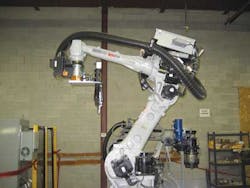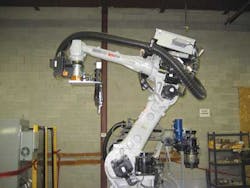Robots protect pipes from shipping damage
Oil pipes are manufactured with threaded ends to enable them to be coupled together in the field. Before leaving a manufacturing facility, the threaded ends of the pipe need caps to protect the threads from damage during shipping.
Traditionally, the protector caps have been applied manually, a slow, labor-intensive operation that requires significant strength.JMP Engineering (www.jmpeng.com) has developed an automated system that uses two robots to complete the task automatically.
The first robot—an HP50 fromYaskawa Motoman Robotics (www.motoman.com) equipped with a Basler (www.baslerweb.com) ace camera—moves the camera above the bin containing the protector caps and captures images of the parts in the bin.
Image data are then analyzed by a Beckhoff industrial PC runningCognex (www.cognex.com) PatMax geometric pattern-matching software. This identifies the location of good thread protectors and detects the presence of any parts that are the wrong size.
Parts are then sequentially removed from the bin and each individual thread protector placed on a table, where the second Motoman HP50 robot picks them up and twists the caps onto the ends of the oil pipes.
Vision Systems Articles Archives

